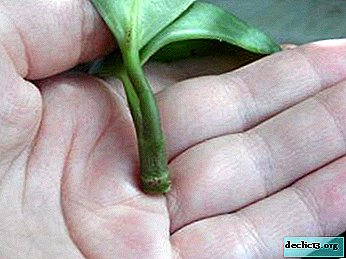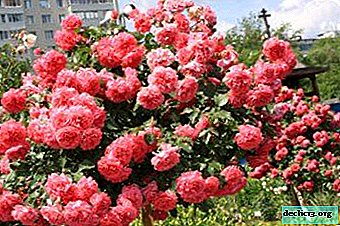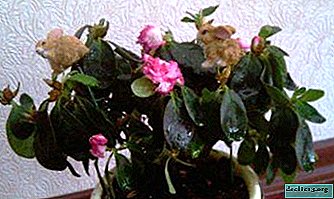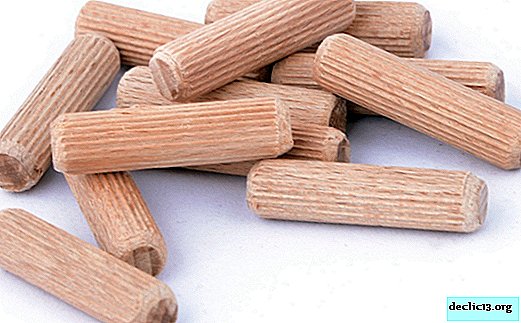What kind of flower is the peperomia of Lillian? Rules for care and reproduction at home

On the windows of offices and apartments there is sometimes a plant with wrinkled leaves and flowers similar to white flags on red poles.
This flower is called Peperomia of the Lillian Caperata. In the article, we will look at how this plant looks.
We learn how to properly care for a flower at home, how to deal with pests and various diseases, and also study the types of reproduction.
Botanical Description
Peperomia caperata (Peperomia caperata), one of the many species of the genus Peperomia from the pepper family. The name of the genus - "Pepper-like" - is due to the fact that peperomia leaves, when rubbed, exude the smell of pepper. In English-speaking countries, peperomia is called "Radiator plant" - "Flower-radiator" and "Baby rubber plant" - "Baby Ficus."
Caperata peperomia (or wrinkled peperomia) was named because of wrinkled leaves. As for the Lilian species, the name was given to it because of the distant similarity of inflorescences with lily flowers. Like most varieties of peperomia, Lillian arose naturally, without the efforts of breeders.The flower was officially described only in 1958, although it was already known in indoor floriculture both in Europe and in America. The American botanist T.J. Yanker, a specialist in the Pepper family, was unable to track the origin of the species and used a herbarium specimen.
Peperomia Lilian is a low herbaceous plant, rarely exceeding 30 cm high. The leaves are emerald green in shape resembling a heart. On the wrong side, the shade is lighter.
The similarity of the flowers of Lillian peperomia with a lily is only external. In fact, on each long brownish-red peduncle, not one blossoms, but many small flowers, collected in the ear. The ear is wrapped in a snow-white covering sheet with a bell at the end. The bell is usually located at an angle to the main part of the inflorescence. It is this covering sheet that resembles a lily flower. The birthplace of the plant is the rain forests of Brazil.
Photo
Further on the photo you can see how the flower looks.




Home Care
Florists note that peperomia are unpretentious plants. However, there are several home care rules that must be followed for peperomia of Lillian caperata.
- Temperature. The plant is thermophilic and does not tolerate cold. In the summer, the temperature should be maintained at 22 ° C, in winter - about 20 ° C, but not lower than 17 ° C.
- Watering. Abundant watering is required during the growth period - in the spring-summer period, but excess moisture is detrimental to the root system. In the autumn-winter period, peperomy should be watered very moderately. Peperomia will not die if you do not water it for several days.
- Shine. The flower is photophilous, but can not withstand direct sunlight for a long time. Preferred windows facing east or west. In winter, you can use fluorescent lamps to extend daylight hours to 8-9 hours (given the period of natural light).
- Priming. Peperomia loves neutral soil. You can buy ready-made soil, or prepare it yourself by mixing turf soil, sheet soil, sand and peat in a ratio of 1: 2: 1: 2. The soil must be loose, otherwise the root system will not be able to develop.
- Pruning. Young plants (up to 2-3 years) are trimmed for decorative purposes - to form a bush. Adult bushes do not tolerate this procedure. First, the plant is carefully inspected, choosing the shoots to be removed. Then these shoots are trimmed with garden shears (it is advisable to sanitize them first). Also eliminate wilted leaves. In addition, inflorescences are sometimes removed so that the young bush can gain strength.
- Top dressing. To feed Lillian peperomia, complex mineral fertilizers are used. From the beginning of spring to the end of autumn, it is fed 2 times a month, in winter - 1 time per month.
- Pot. Peperomia Lilian can be grown in both clay and plastic pots. It should not be too large in size.
 Transfer. A young plant (up to about 3 years old) is transplanted every year, then once every two years or less, as necessary. When transplanting, a pot with a diameter of 2 cm larger than the previous one is used, and a little deeper. To eliminate moisture stagnation, a drainage layer of about 6 cm (expanded clay, broken brick, eggshell, etc.) should be put on the bottom. Before transplanting the plant, it is advisable to calcine or steam the soil to kill fungal infections and pests.
Transfer. A young plant (up to about 3 years old) is transplanted every year, then once every two years or less, as necessary. When transplanting, a pot with a diameter of 2 cm larger than the previous one is used, and a little deeper. To eliminate moisture stagnation, a drainage layer of about 6 cm (expanded clay, broken brick, eggshell, etc.) should be put on the bottom. Before transplanting the plant, it is advisable to calcine or steam the soil to kill fungal infections and pests.The peperomia bush is carefully removed from the pot (holding the pot on both sides) along with a lump of earth. Then, the soil is shaken off the roots and washed, being careful not to damage. Soil in a new pot moisten. The bush is placed in a new pot, spread the roots, sprinkle them with earth, but do not ram. The soil is moistened again, and when it settles, they add a new one. Water from the sump must be drained.
- Wintering. In winter, reduce the amount of watering and top dressing and provide additional lighting, as described above. In no case is it allowed to drop the temperature below 15 ° C. Drafts must be eliminated - a stream of icy air can kill a plant.
Breeding
Peperomia Lilian is propagated in the following ways.
Cuttings
The most common method of reproduction.
- The stem is taken from the stem or top. The main thing is that the handle has at least two nodes.
Reference. A node in botany is a segment of the stem on which leaves, branches, aerial roots, buds and other lateral organs form.
- Pruning of cuttings is carried out in late spring or early summer.
- The knife must be disinfected.
- Cuttings can be put in water and wait for the roots to appear. They can also be planted directly in the prepared soil.
- Before this, the petioles are placed for two hours in a solution of potassium permanganate or a special tool that stimulates the formation of roots (the cut should be directed down).
 After two hours, the cuttings are removed from the solution, the cut is sprinkled with chalk or crushed activated carbon, and dried over the course of a day.
After two hours, the cuttings are removed from the solution, the cut is sprinkled with chalk or crushed activated carbon, and dried over the course of a day.- Then they are planted in the prepared soil. Also for rooting, you can use moss, sand, peat chips or vermiculite.
- About a month - before the formation of roots - the cuttings are kept in greenhouse conditions. To do this, use glass jars, or plastic bottles, cut to the required size. The soil should not dry out during this period.
- When the cuttings take root (this occurs in 80% of cases), they need to be planted in separate pots.
Leaf cuttings are also used. All the same procedures as for cuttings are performed for individual leaves. An adult plant is selected (at least three years old). Petiole should be shortened as much as possible.
Dividing the bush
A normal transplant is performed, as described above, but the roots need to be separated from each other and the resulting several plants will be planted in separate pots.
Seeds
A fairly time-consuming method, suitable for experienced gardeners. Seeds may well ripen at home, You can also purchase them at a special store.
- Shallow flat containers are taken for sowing, the soil consisting of special soil for decorative deciduous plants with the addition of river sand is filled in them.
- The soil is moistened, seeds are laid out on its surface, after which another 1.5-2 mm of soil is poured.
- Using a spray gun, moisten the soil again and cover the containers with glass or plastic wrap.
- Pots must be kept in bright light and at a temperature of 24-27 ° C (you can heat them from below).
- Every day you need to ventilate the crops for 5-7 minutes to avoid rot.
- Spray the soil, not allowing it to dry.
- When 1-2 real (not cotyledonous) leaves appear, the plants are planted in peat pots with soil for peperomia.
- Six months later, when 6-7 leaves are formed on the shoots, they are transplanted into pots with a diameter of 7-8 cm.
Bloom
This variety of peperomia is one of the few varieties of a plant whose decorative value is not only leaves but also flowers. Therefore, the buds are not pruned, as in other species, but let them bloom. It blooms in summer. As flowering takes a lot of power from the plant, during this period, additional nutrition is required. If seed reproduction is not planned, it is better to prune faded peduncles.
Diseases and Pests
 Proper care is the key to the health of Lillian peperomia.
Proper care is the key to the health of Lillian peperomia.
With a lack of moisture, it can lose leaves, an excess of moisture leads to rotting of the roots. Weakened plants can be affected:
- spider mite;
- mealybug;
- thrips;
- nematodes.
In this case, you should treat the plant with special insecticides, or use improvised means. So, an alcohol solution helps from a mealybug - a piece of cotton wool is moistened in it and the plant is wiped. In case of damage with a spider mite, a bush is soaped with a sponge, then it is washed under a warm shower.
Similar flowers
Peperomia Lilian has many close and distant decorative relatives of this species.
- Emerald ripple (Emerald ripple) - another species species. It is valued for its beautiful shriveled leaves of a dark green color, but, unlike Lilian, its flowers are not so decorative. In English sources, the name Emerald ripple peperomia is sometimes used as a synonym for the name of the whole species (Peperomia caperata).
- Burgundy Ripple ("Burgundy Ripples") similar to peperomia Emerald ripple, but different burgundy leaf color, reminiscent of Burgundy wine.
- Silver Ripple ("Silver Ripples") differs in light green leaves with contrasting dark grooves.
- Lemon ("Lemon") has an even lighter shade of leaves.
- White lady ("White Lady") - variety with white spots on the leaves.
Peperomia of the Lillian Caperata is a beautiful plant, which is easy to grow at home. If you follow the simple rules of care, it will be pleasing to the eye for many years.

 Transfer. A young plant (up to about 3 years old) is transplanted every year, then once every two years or less, as necessary. When transplanting, a pot with a diameter of 2 cm larger than the previous one is used, and a little deeper. To eliminate moisture stagnation, a drainage layer of about 6 cm (expanded clay, broken brick, eggshell, etc.) should be put on the bottom. Before transplanting the plant, it is advisable to calcine or steam the soil to kill fungal infections and pests.
Transfer. A young plant (up to about 3 years old) is transplanted every year, then once every two years or less, as necessary. When transplanting, a pot with a diameter of 2 cm larger than the previous one is used, and a little deeper. To eliminate moisture stagnation, a drainage layer of about 6 cm (expanded clay, broken brick, eggshell, etc.) should be put on the bottom. Before transplanting the plant, it is advisable to calcine or steam the soil to kill fungal infections and pests. After two hours, the cuttings are removed from the solution, the cut is sprinkled with chalk or crushed activated carbon, and dried over the course of a day.
After two hours, the cuttings are removed from the solution, the cut is sprinkled with chalk or crushed activated carbon, and dried over the course of a day.















